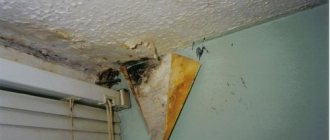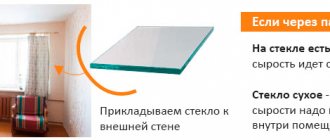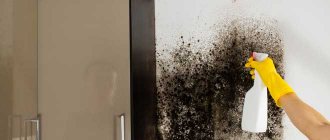In private homes, as in any other residential premises, it is very important to create and maintain comfortable microclimatic parameters. The air should be heated to the optimal temperature and saturated with moisture at a level of 40-60%. It is also important to pay attention to the organization of the ventilation system (in accordance with DBN V.2.5-67-2013 standards). Otherwise, the air will stagnate, accumulate odors, and become heavy.
Errors in organizing air circulation lead to dampness. Since excess moisture is not removed outside, it accumulates in the air, creating an uncomfortable environment. When humidity is above 65%, the growth of pathogenic microflora sharply increases, building structures of the house are destroyed, finishing and furniture deteriorate.
Consequences of high humidity in the house
Breathing such air is dangerous to health: the immune system, working in a state of “constant combat readiness,” will sooner or later fail. The risks of respiratory and allergic diseases increase sharply. High humidity in the house is especially harmful for children. Their immune system is just beginning to form, so it is not ready for excessive stress. It is also not recommended to breathe waterlogged air for the elderly and people suffering from asthma and allergies.
Why is high humidity in an apartment dangerous?
We were prompted to write this article by the story of one of our employees. She had an apartment in the city center, where she did a good renovation. After about six months, the woman noticed that she and her young child were often sick, and red, scaly spots began to appear on her body. Trying to understand the cause of the rash, she took an allergy test, which showed that the allergen was black mold.
Then our employee remembered that, indeed, the apartment felt damp and there was mold in some places, which she simply cleaned with a damp cloth. As a result, the situation was greatly neglected. She did not want to waste time dealing with dampness in the apartment and simply sold it at a price an order of magnitude lower than the market value. And this is a good example of what not to do.
Black mold on walls and furniture is the result of high humidity in the room
Therefore, if you notice that you have high humidity in your apartment, start taking action immediately. After all, from too humid indoor air:
- Even high-quality furniture deteriorates prematurely;
- household appliances break down;
- the decoration of the apartment deteriorates (the paint is cracking, the wallpaper becomes moldy and peels away from the walls);
- an unpleasant smell of dampness appears;
- mold grows in corners, walls, furniture;
- residents get sick more often, they develop problems with the respiratory system and have an allergic reaction (rashes, cough, nasal congestion, etc.).
On a note! First of all, the human body, natural leather, wood and paper suffer from dampness.
The severity of the consequences of high humidity in a room depends on how much the permissible values are exceeded and how long the situation remains uncontrolled.
Prevention measures
Preventative measures to prevent high humidity in the house include the following:
- Carrying out waterproofing work to prevent moisture from entering rooms - eliminating leaks, ensuring the tightness of windows, sealing floors, insulating walls, etc.
- Cooking food must be covered. This will prevent the formation of steam and, as a result, an increase in humidity.
- The premises should not be used for other purposes.
- It is necessary to regulate the permissible number of water containers in one room.
- Installing a hood in the kitchen will reduce moisture levels in the air.
- Checking the functionality of the ventilation system and repairing it, if necessary.
- If the room is damp, it is not advisable to place aquariums in it.
- Choosing reliable plastic windows is one way to prevent excess humidity.
- It is best to move drying clothes outside or to the balcony, avoiding hanging wet things indoors.
What should be the humidity in the apartment?
It is important to understand what humidity indicator is considered high. Relying only on personal feelings is not entirely correct. So, when the humidity is slightly higher than normal and the temperature in the room is above +24°C, you can feel like you’re in the tropics and think that the situation is critical. Or vice versa, the temperature in the room will be within normal limits, but the humidity will be much higher, but you may not notice it.
Temperature and relative humidity standards - from optimal to maximum permissible - are presented in the table based on the recommendations of GOST 30494-2011.
| Room | Air temperature, °C | Relative humidity, % |
| Living room | 18-24 | 40-60 |
| Adults' bedroom | 18-24 | 40-50 |
| Children's room | 18-23 | 45-60 |
| Kitchen | 18-26 | 40-60 |
| Bathroom | 18-26 | 40-60 |
| Study | 18-26 | 40-60 |
On a note! Optimal indicators for an apartment or house as a whole: humidity - 40-60%, air temperature - 20-23 ° C.
Humidity norm in winter and summer
Experimental studies of the impact of humidity levels on the human body have shown that optimal indicators also depend on the time of year. According to the adopted GOST and recommendations of experts:
- in winter (during the cold season), normal humidity is considered to be from 30 to 45%;
- in summer (during the warm period) the normal humidity in the apartment is 30-60%.
If the humidity in your apartment rises above 60% in winter and above 65% in summer, then this is a reason to take measures to reduce it.
On a note! During cold times, air humidity is lower because cold air retains water vapor less well than warm air.
For children
A child's body is even more vulnerable than an adult, therefore, if there is a child in the house, it is simply necessary to control the humidity.
Humidity standards for children:
- according to GOST 30494-2011 standards - from 30 to 45% in the warm season and from 30 to 60% in the cold season.
- according to the recommendations of many pediatricians, for example, Dr. Komarovsky , the ideal humidity for a child is 50-60%. A figure above 70% will be critical.
Humidity due to poor ventilation
Very often, the cause of dampness is poor performance of the ventilation system or its complete absence. After eliminating this problem, the humidity level can be significantly reduced.
Ventilation cannot work properly due to:
- obstruction;
- poor sealing;
- improperly equipped exit above the roof;
- insufficient cross-sectional area of the ventilation duct.
To restore normal ventilation, you need to invite a specialist. He will inspect the system and determine the cause of the problem.
A clogged system must be cleaned:
- remove the grille;
- wash it with detergent;
- remove dirt from the walls using a scraper;
- vacuum the channel;
- wash it with a damp cloth (as far as your hand can reach);
- put the ventilation grille in place.
The ventilation shaft is clogged.
At high humidity, you can use a forced ventilation system: reversible, exhaust or supply. It is installed in the ventilation duct. When there is no ventilation in the house at all, you need to make a through hole in the wall and install a recuperator in it. It must be covered with bars from the inside and outside.
Might be interesting
Waterproofing
How to choose the right floor waterproofing for screed?
Waterproofing
Foundation waterproofing: optimal choice of technology
Waterproofing
Clean water is the key to health, waterproofing concrete…
Waterproofing
Instructions for waterproofing a swimming pool
Another reason for dampness is improper installation of double-glazed windows. If mold appears on the window slopes, you need to level them and foam the cracks again. To prevent condensation from settling on the glass, do not clutter the window sills. This prevents the normal circulation of warm air. Window sills that are too large lead to the same consequences. To fix this, you need to drill holes in them.
Important! Fans, hoods and air conditioners need to be cleaned regularly. Otherwise, the device itself will become a source of bacteria and mold.
Windows that are too sealed are also a cause of increased humidity. How to lower the humidity level in this case? The problem of dampness can be solved using a window pressure ventilator, a hydraulically controlled ventilation valve or a vent fan. You can simply remove the rubber seal on top of the window frame. There is no need to do this with all double-glazed windows at once: first treat one window, then (if that doesn’t help) the next one, and continue until the result is obtained.
How to determine air humidity in an apartment
If you have high air humidity in your apartment, you will most likely notice it by the following signs:
- Condensation forms on the windows - “the windows are crying”;
“Crying” windows are one of the indicators of high humidity in an apartment
- the bed seems damp;
- things in the closets smell damp;
- things in the room take too long to dry;
- book pages are damp;
- when the air temperature in the room rises even slightly, it becomes very stuffy;
- mold on furniture and decoration.
Important! A special device will help determine the level of humidity in an apartment - a non-contact hygrometer or a household weather station.
The hygrometer shows air humidity, sometimes temperature and other important indicators
The device shows the relative humidity in the room. Relative humidity is expressed as a percentage and indicates how far the steam is from saturation. To put it simply, steam is far from saturation (formation of water droplets) - the humidity is low, steam is close to saturation - the humidity is high.
This indicator is often confused with absolute humidity, but it only indicates the water content of the air by mass. It has been proven that a person does not feel this measure, but perceives the moisture content in the air as a ratio to the maximum possible value. That is, it is relative humidity that is important for us.
The humidity indicator will always be in sight if you hang a clock with a weather station on the wall.
buybuy
Wall clock with a built-in hygrometer and thermometer - the ability to always control the comfortable atmosphere in the room
If you don’t have a hygrometer, but want to measure humidity urgently, then you can use improvised means .
1. A fir cone with slightly straightened scales will show whether the air in your room is dry or humid. To do this, place it away from heating devices overnight. If the air is dry, the scales of the cone will open; if the air is humid, they will close.
Humidity by fir cone - a simple folk method, but the most reliable
2. Pour cold water and leave it in the refrigerator for an hour. Then take out the glass and place it in the room (again, away from heating devices). Due to temperature changes, condensation forms on the walls. If these drops of water dry within 15 minutes, then the air in the room is dry. If the drops do not dry for a long time, but flow down, the air humidity is increased. The condensation does not evaporate quickly, but does not flow down either - the humidity is within normal limits.
The humidity in the room is high if condensation flows in drops along the walls of the glass
How to determine air humidity by dew point
Dew point is a concept that should not be overlooked when talking about air humidity.
Important! Dew point is a measure of the temperature at which steam turns into water droplets. Depends on temperature and humidity.
In a room with dry air, the temperature must drop significantly for the steam to turn into condensation. Conversely, with high air humidity, the slightest drop in temperature leads to water vapor condensing and droplets forming - dew.
Knowing the air temperature and relative humidity in the room, you can easily determine the dew point value using the table below.
Determining the dew point is important to prevent the formation of dampness
Determining the dew point allows you to understand what ratio of temperature and air humidity will lead to the formation of dampness and mold. For example, the air temperature in the room is +21°C, and the relative humidity is 70%. Then point 15 will be critical. If the temperature on any surface of the room drops to +15°C, then moisture will immediately form on it.
The most vulnerable places in an apartment are windows and corners adjacent to the street. This is where the dew point is most often reached, so insulation and sealing should be considered first.
The dew point value also affects the human body. Which indicator is well tolerated and which requires adjustment, see the table.
The table helps you understand what dew point value you should strive for
When indoor humidity exceeds 60%, constant monitoring and measures to reduce it are required.
Remedies
There are several ways to quickly remove high humidity. You need to take into account the specifics of the room, its area and the ability to implement one or another method of air drying.
Ventilation
Ventilation does not remove the smell of dampness and neutralize high humidity in all cases. This method will help if the weather outside is dry.
It will also be useful:
- Ventilate the bathroom after bathing and heavy laundry.
- Organize good air exchange in the room in which food is prepared.
- Ventilate the room after wet cleaning and other work using large amounts of water.
Heating
Warming up the room during the cold season, when the air temperature inside the building increases significantly, also helps to reduce humidity levels. The result can be achieved by installing additional heating devices - heaters.
When using heaters, there is a danger of drying out the room , and then you will have to deal with another problem - increased dryness. Therefore, it is important to maintain a middle ground.
Special tablets
One solution to the problem of increased dampness is to purchase special tablets that contain absorbent components. They are used with desiccants - containers for collecting the solution that is formed from absorbed moisture.
The productivity of the tablets is up to 400 ml of water per month in a room of up to 20 m². On average, such a tablet should be enough for 2 or 3 months of use.
Products from such well-known manufacturers have good reviews:
- "Stop humidity" from Henkel;
- “Stop moisture” from Ceresit and others.
Folk remedies
Absorbents, which can be used as improvised means, will help dry humid air:
- sugar;
- coffee beans;
- salt;
- rice.
These products have the ability to absorb increased moisture. To normalize humidity, these products can be placed in containers - several per room.
In addition to removing moisture from the air, the products listed can remove unpleasant odors .
For non-residential utility premises, the following containers placed in containers will help remove excess moisture from the air: quicklime, coal, calcium chloride. This method is suitable for damp basements, garages, workshops, etc.
Dehumidifiers
Special devices are used to force dry the air in the room. They allow you to achieve results even in cases where other methods of combating moisture have not helped.
Operating principle of the devices:
- Air absorption through the evaporator.
- Liquid conditioning occurs in the device due to temperature differences. The water flows into a separate container.
- The flow of dried air is returned back into the room.
The advantages of dehumidifiers are the ability to dry even very humid air in a short time.
There are two types of devices:
- Stationary.
- Portable.
The choice depends on the intended use of the device and whether it will need to be moved. It should be borne in mind that stationary models are more powerful, larger, and are not intended to be moved from place to place. For apartments, preference is most often given to dehumidifiers that can be moved from place to place.
The power of the dehumidifier is a very important parameter that must be taken into account when purchasing a device.
NeoClima ND-10AH
Floor installation is designed for rooms with an area of 16 m² . The weight of the device is 11.5 kg. The productivity of the device is 10 liters per day. The model has a filtration system to remove dust particles and wheels to move the device.
The NeoClima dehumidifier is equipped with a timer and display, which makes operation easier. Operating modes – 2, power – 0.23 kW. The volume of the container for collecting condensate is 1.5 l.
Additional functions:
- when the container is filled with condensate - automatic shutdown;
- automatic defrosting.
Price – up to 12,000 rubles. Read reviews here, here and here.
Electrolux EDH-12L
The device is designed for floor or tabletop use in a small room with an area of 15 m², and has a carrying handle. The power declared by the manufacturer is 0.245 kW . The weight of the device itself is 10 kg.
Electrolux has 4 operating modes, productivity – 12 liters per day. The volume of the condensate container is 2.2 liters. The device is completely ready for use and does not require additional installation. The model has indicators and a display.
Additional functions:
- ability to set shutdown time;
- the presence of a clothes drying mode.
The cost is on average about 13,000 rubles, at some points of sale – up to 17,000 rubles. Read reviews here.
Ballu BDM-30L
The Ballu dehumidifier is a floor-standing unit that has electronic controls for quickly setting settings, a built-in timer, indicators and display. The device allows you to dehumidify the air in a room of 50 m². Capacity – 30 liters per day .
The volume of the condensate container is 5 liters. Maximum power – 0.54 kW. The weight of the entire device is 14.6 kg.
Additional functions:
- Air ionization.
- Automatic shutdown when the container is full of condensate.
- Possibility to adjust fan speed.
- Set off and on times.
- Clothes drying mode.
Cost – about 22,500 rubles. Read reviews here and here.
Causes of high humidity
But before you deal with humidity in your apartment, it is important to understand why it formed. Main reasons:
1. Poor ventilation. According to building codes, ventilation ducts must be in every apartment. But in practice, they are often clogged with debris, installed incorrectly, and sometimes completely absent.
The photo shows an example of a separate ventilation system for a bathroom
2. Incorrect insulation. In this case, the thermal and waterproofing of the room is compromised. It will be too hot here in the warm season, and cold in the winter. The problem can only occur in one room, usually the corner one.
3. Builders' mistakes. Often, a lot of dampness appears after a good renovation in an apartment. Modern windows, seals, thick layers of plaster, plastic and other dense finishes provide airtightness, but make ventilation difficult. And if the builders violated the installation technology, then problems with dampness cannot be avoided.
4. Violation of thermal balance. The presence of such a problem can be noticed by the formation of constant condensation - on windows, walls and any other surfaces. The concept is closely related to the “dew point”, which we talked about a little higher. It’s good if the dew point does not fall within the boundaries of the apartment at all, but is located closer to the outside of the building.
The dew point directly depends on the correct insulation of the walls
5. A constant source of moisture in the apartment. This could be faulty leaking plumbing or heating pipes, a bathroom without ventilation, “crying” windows, or frequent cooking in the kitchen without a hood. Additional sources include indoor plants, an aquarium, and wet laundry that is dried in the apartment.
Leaking plumbing is the most common cause of dampness and mold.
6. External factors. Here we include causes that are difficult or impossible to eliminate, but their consequences can be corrected. This is a dilapidated roof (for the top floor) and leaks from neighbors, the location of the apartment above a basement or other room with high dampness, the presence of a nearby reservoir or groundwater leakage (for a private house).
You will see such smudges and mold on the ceiling if dampness comes from neighbors above or from the roof
Often there is not one reason, but several at once, then you will have to put in a little more effort.
On a note! The risk group includes corner apartments and those located on the ground floor. As well as houses built in damp places or near bodies of water.
Check your apartment for each factor on the list above. Having determined the cause of high humidity, you can begin to combat it.
Causes of dampness in a private home
We didn’t think about what exactly was the source of mold in our home. Because all possible factors suited our situation perfectly. Among the reasons that contribute to the appearance of dampness are the following:
- Roof. If there are cracks and the slightest unclosed gaps in the roof, any type of precipitation gradually penetrates into the home. At first, there are no signs of leakage on the ceiling, but over time, moisture accumulates, causing the development and spread of fungus.
- Foundation. The lack of low tide was the impetus for the beginning of the destruction of the foundation of the house. Plus, there were water pipes running under the floor that were leaking, and thus the foundation was washed out and dampness accumulated under the floor covering.
- Walls. They may be partially destroyed and covered with cracks. In our case, mold formed on them due to the lack of an exhaust hood in the bathroom and in the hallway.
- Wall covering. If the room is lined with plastic or other similar material, then it cannot “breathe”, which leads to the accumulation of moisture and the formation of mold.
- Underground. In the absence of supply and exhaust ventilation, dampness accumulates in a short time. In this case, the smell along with the fungus spreads throughout the entire home.
- Groundwater. When they are located close together, it is necessary to have high-quality waterproofing performed both inside and outside the house.
Attention! Dampness in a new wooden house can be caused by the use of undried wood during construction.
How to dry a house from dampness: reducing humidity
You measured the humidity level in the apartment, and it turned out to be higher than normal. The reason has been identified. What's next? We recommend not only eliminating pockets of dampness, but carrying out systematic work. To do this, you will need proven ways to get rid of humidity in an apartment.
Eliminate all sources of moisture
For this:
- Check all pipes, plumbing, and radiators in the apartment for leaks. Eliminate them if necessary.
- Leaky pipes, flooding of the basement, problems with the exhaust system and roof - problems that must be solved by the management company or housing and communal services. Contact them with a corresponding statement.
- Do not dry clothes in the apartment.
- Consider getting rid of an aquarium if you have one and reducing the number of houseplants.
- Make sure the installed plastic windows and slopes are tight.
It will be difficult to notice leaking hidden pipes. But usually it can be seen on the ceiling of the neighbors below. Be sure to ask them if there are any leaks on their ceiling. Check for the same smudges on your ceiling, because the problem of dampness may come from your neighbors above.
Hidden pipes are usually hidden behind drywall. This is aesthetically pleasing, but inconvenient in case of leaks
Think about proper insulation
A wall that is too thin, poorly sealed seams and lack of good insulation will only aggravate the problem. Add to this poor heating and seasonal temperature fluctuations - and dampness cannot be avoided.
If the insulation is not done correctly, and there is an empty gap between the wall and the insulation layer, then it is in this gap that moisture will form. Sooner or later, the owners of such apartments have to think about what to do if there is high humidity in the apartment. Then they carry out the correct insulation, the dew point shifts to the level of the insulation, and the dampness gradually leaves the apartment.
Proper insulation is the key to the absence of dampness in the apartment
So, the following will help to radically eliminate the cause of dampness:
- insulation, waterproofing and sealing of walls from the outside and inside;
- waterproofing of floors (for the first floor).
Provide forced ventilation of the room
The ventilation may be clogged, blocked by household appliances, furniture or finishing materials. Or perhaps it simply cannot cope with the outgoing flow of moist air..
To eliminate poor ventilation:
- Check the existing system for draft. Clean hoods regularly from dirt. The shaft in the general system may also be clogged, then contact the management company with a request to clean the ventilation duct.
- Be sure to turn on the kitchen hood while cooking.
Turn on the hood in the kitchen, even if you are just boiling the kettle
- Install a check valve on each vent. Sold separately and complete with fan and grille.
Installing a check valve on the hood will help combat high humidity
- Install duct fans in the duct inlets in the bathroom and kitchen. The devices operate from the mains and provide forced air ventilation. Or a ventilation wall valve. The device is mounted in a wall with an exit to the outside.
The wall valve will create forced air ventilation
Watch a useful video on how to install a hood and ventilation with your own hands.
A regular fan can also help maintain the circulation of moist and dry air and reduce the accumulation of condensation. An interesting option is lamps with a fan. They not only perform a practical function, but also complement the interior.
Special devices
One of the most effective ways to get rid of humidity in your apartment is to install a dehumidifier. The device extracts moisture from the air and removes it in the form of condensate into a special container.
A dehumidifier helps reduce indoor humidity
When choosing a dehumidifier for your apartment, pay attention to the main parameters:
- Performance. It’s good if it is equal to the product of the area of the room by a factor of 0.7. That is, for a room with an area of 20 m², a dehumidifier with a capacity of at least 14 l/day will be optimal.
- Noise level. The indicator does not affect the result, but affects the comfort of household members. Dehumidifiers with noise levels greater than 45 dB can cause irritation and sometimes interfere with sleep.
- Air exchange. The device should process the air in the room 3-4 times per hour. For a room of 20 m², you should choose a dehumidifier with a capacity of 150 m³/h or more.
Conventional air conditioners with a dry function also do a good job of drying air. If the air temperature allows, then use the heater more often or turn on the heating if it is individual. .
The effect of dampness on housing and people
In case of untimely actions aimed at eliminating dampness, or in case of ignoring the problem, unpleasant consequences will certainly arise.
- A persistent heavy smell characteristic of basements will appear in the apartment
- Finishing materials, namely wallpaper or plaster, will begin to peel off. The putty saturated with moisture becomes loose and moves away from the surface of the wall or ceiling in whole layers;
- Wooden floors or floor coverings may become deformed, cracks will form at the joints of elements, and a characteristic creaking will appear;
- Furniture items made from natural materials will also be subject to deformation;
- In the case when the humidity level exceeds normal levels for humans of 40-60%, this leads to aggravation respiratory diseases or their development;
- Allergies may worsen;
- All microbes and bacteria develop much faster and more actively in a humid environment;
- Skin rashes will appear, wounds or scratches will take longer to heal or rot;
- Such a microclimate is especially dangerous for young children, whose immunity has not yet strengthened and cannot provide adequate resistance. Children are easily susceptible to illness and stay sick longer;
- A clear consequence will be education on the walls or ceiling of black fungus, that is mold.
How to get rid of the effects of dampness: odor and mold
High humidity in a house or apartment does not go away without leaving a trace. Usually it leaves behind unpleasant consequences - the smell of dampness and mold. The following measures will help get rid of them:
- Remove all contents of cabinets and nightstands. Wash and dry things well in the sun. Wipe the cabinets inside and out with a vinegar solution and leave to air for 2-3 days.
- Use a solution of bleach and water (ratio 1/10) to treat all mold-affected areas of the apartment.
- You can use hydrogen peroxide instead of bleach. Wipe the moldy surfaces with the solution, then wipe with a damp and dry cloth.
- Vinegar works well against mold and mildew. Using a spray bottle or rag, apply table vinegar to areas with black mold. Then rinse and wipe dry. Repeat the procedure once a week until the problem disappears.
- Use professional products: antifungal, anti-mold aerosols to disinfect premises
Professional antifungal agents will help get rid of mold
Causes of the problem
Constantly high humidity in the room must have a specific reason. In some cases, the source of moisture can be determined quickly.
This may be an external defect during the construction of the facility or one that arose during operation as a result of wear and tear of structural elements:
- leaking roof;
- violation of the integrity of the outer wall, the tightness of the slabs;
- flooding;
- ventilation system defect.
Internal reasons for the appearance of high humidity include violation of operating rules:
- the location of several aquariums or other open containers with water in a room that is not designed for this;
- growing tropical or other plants that require abundant watering in large quantities;
- frequent drying of large amounts of laundry;
- cooking food in open pans;
- lack of sealing of windows;
- leaks in pipes (sewage, water supply, heating).
If a source of high humidity is identified, it should be eliminated.
Insufficient room heating
In apartments with an individual heating system, the problem of high humidity may arise due to insufficient heat levels. This can happen due to:
Recent posts Soldering or crimping electrical wires Chopped houses: technical features and advantages Interior in Scandinavian style
- Incorrect boiler settings and insufficient temperature settings (before starting to operate the equipment, be sure to consult a specialist);
- Installation of additional panels on radiators (in order to improve the aesthetic characteristics of devices or protect children from hot surfaces);
- A thick layer of paint on the batteries (formed as a result of repeatedly painting the device).
Also, the reason why it is humid in the apartment may be the “amateur action” of the neighbors, who decided to remove some of the pipes to reduce costs.
Solution to the problem : check the functionality of the heating system, configure the equipment correctly, remove all additional panels from the radiators, and before painting the batteries (if necessary), be sure to remove the previous layer of dye from the surface of the equipment.
The source of moisture is under the floor
If there is no ventilation in the underground, it is necessary to equip it. Waterproofing walls and floors, sealing gaps and cracks help to significantly reduce the level of humidity at home. For this, waterproofing plaster is used.
Dampness in the cellar may appear due to leaky construction pits. To eliminate the problem, you need to seal it with waterproof clay (clay castle).
Foundation drainage device
Changes in groundwater levels lead to dampness in the house. To solve this problem, you need to properly organize the drainage system.
Another reason is poor foundation waterproofing.
In this case, vertical waterproofing is necessary:
- coating waterproofing;
- penetrating compounds;
- vertical lining of the foundation with waterproofing.
Note! The service life of waterproofing materials is not infinite. In an old house, it may be out of order.
Failure of double glazed windows
Like ventilation systems, window structures fail over time. This is especially true for seals installed on the inside of the frame. The degree of protection that a double-glazed window provides largely depends on it. In this case, the reason why the apartment is very humid can be explained by the natural wear and tear of the seal. To check its current status you need to:
- Open window;
- Press the rubber seal with your finger.
If the compacting layer quickly returned to its original position, it means it is still performing its working functions. If the rubber retains a dent or does not bend at all under pressure, it’s time to change it.
Solution to the problem : replace the glass seal (by contacting a specialist in the appropriate direction).
Mold on plastic windows
Visible traces of fungus can be removed with improvised means: bleach, ammonia and ordinary detergents. In this way you will not kill the mold, but will only “spoil its life” a little. The fight against mold should take place in several stages; this is the only way you can be completely confident that you have defeated it completely and irrevocably.
- First stage: clean the surface. As a rule, slopes are the source of the problem. If the side surfaces of your window opening are decorated with plastic panels and characteristic stains appear on them, then there will be fungus under the plastic.
- Second stage: we treat the slopes with antifungal compounds.
- Third stage: consolidate the result. Don't stop there. In order to prevent mold from appearing on plastic windows again, it is necessary to use waterproofing agents.
How to get rid of condensation on PVC windows - video
Insufficient ventilation
Problems with the ventilation system can arise not only due to its incorrect design, but also during its natural operation. Over time, the ventilation becomes clogged and accumulates a layer of dust and small debris. As a result, air flow slows down. In most cases, the reason why there is dampness in the apartment is typical for old buildings. In modern buildings, ventilation systems are built of sufficient quality and have a long service life.
Solution to the problem : install an additional ventilation system or contact a management company, which will have to clean the already installed ventilation or replace it.










